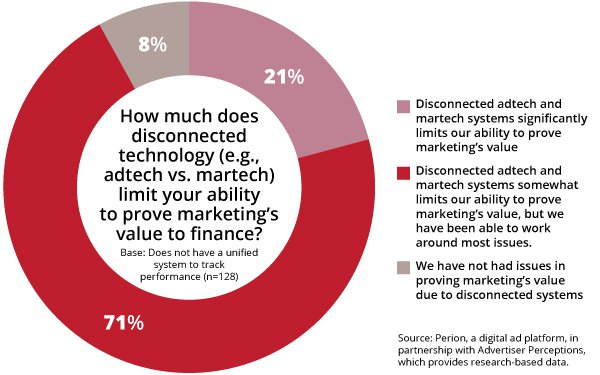
Marketers using an integrated framework or digital
platform that consolidates data, processes, and tools from various sources into one view to manage and improve performance across different domains face fewer barriers when it comes to proving value
for the company.
This type of strategy typically outperforms others on key business metrics, and is more likely to align successfully with chief financial officers (CFOs) -- the ones
pulling the purse strings shut. Only 23% of marketers currently have this type of framework in place, according to findings in a recent study.
Evidence of progress -- and proof that
fragmentation still exists -- is found in the study conducted by digital ad platform Perion, in partnership with Advertiser Perceptions, which provides research-based data.
The duo set out to understand the relationship between CMOs and CFOs. They said a better understanding helps to identify how CMOs can more effectively be seen as a primary driver of growth for
their companies vs. a cost center. Despite some progress, a fog clouds the CMO-CFO relationship.
advertisement
advertisement
Fragmentation is the culprit. Marketing data as well as ad and tech spend are spread across too
many channels, systems, and partners.
Without a unified view, CMOs struggle to deliver the kind of proof CFOs need to fully grasp the impact of marketing. This study suggests a solution.
Companies that experienced a much stronger relationship between CMOs and CFOs adopted a unified system or structure for tracking advertising performance across technology, partners and
platforms.
Measurable proof -- especially when it comes to business outcomes and not just brand awareness -- remains elusive without a unified system to connect all marketing efforts,
according to the findings.
Sixty-two percent of executives said they need better tools to clearly show the contribution of marketing to the bottom line. (Where are the chief technology
officers?)
CMOs said they are working to prove the return on investments for their programs, and many believe CFOs are starting to recognize that effort too. In this study, 62% of marketers
said their CFO now views marketing as a “revenue driver with measurable proof.”
The data also shows that one major shift could dramatically improve marketers’ ability to
prove their impact -- that unified system. Some 92% of marketers said disconnected technology at least somewhat limits their ability to demonstrate the value of marketing, and nearly three in four
called a unified tracking system a “must-have” when asked to envision the future of marketing performance.
When a unified system is in place, the outcome changes. Among the 23% of
marketers who already use unified measurement, there is a clear boost in trust, collaboration, and performance between CMOs and CFOs.
These teams report stronger CFO support and advocacy at
the board level as well as stronger alignment on budgets, expectations, and metrics and fewer barriers to proving ROI, such as gaps in analytics or challenges with measuring omnichannel
performance.
Marketers using a unified measurement system were significantly more likely to say their CFO trusts the metrics they report -- particularly when it comes to ROI and other key
business outcomes.
Compared to those without a unified system, marketers with a unified system saw closing of major gaps in trust. ROI rose 22 percentage points, while marketing share rose 17
percentage points, incremental revenue rose 26 percentage points, lead generation rose 17 percentage points, customer lifetime value rose 19 points, brand awareness rose 18 points,
purchase intent rose 45 percentage points, and share of voice rose 29 percentage points. (Percentage points are being used to show the growth.)
The methodology for the study is
simple. Perion, in partnership with Advertiser Perceptions, surveyed 167 U.S. and Canadian marketers from August 28 to September 10, 2025.
The marketers surveyed were senior-level
decision makers responsible for budgeting and oversight of marketing programs spending a minimum of $1 million annually on advertising. Although the number of marketers surveyed was not high, the
financial investment was significant.